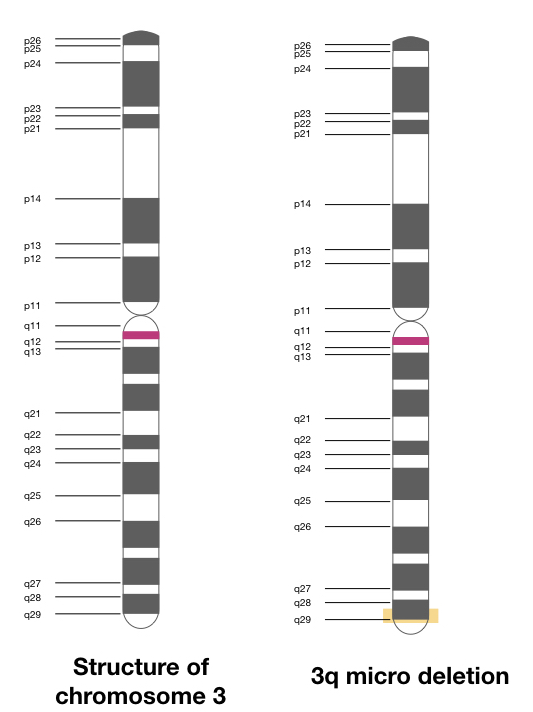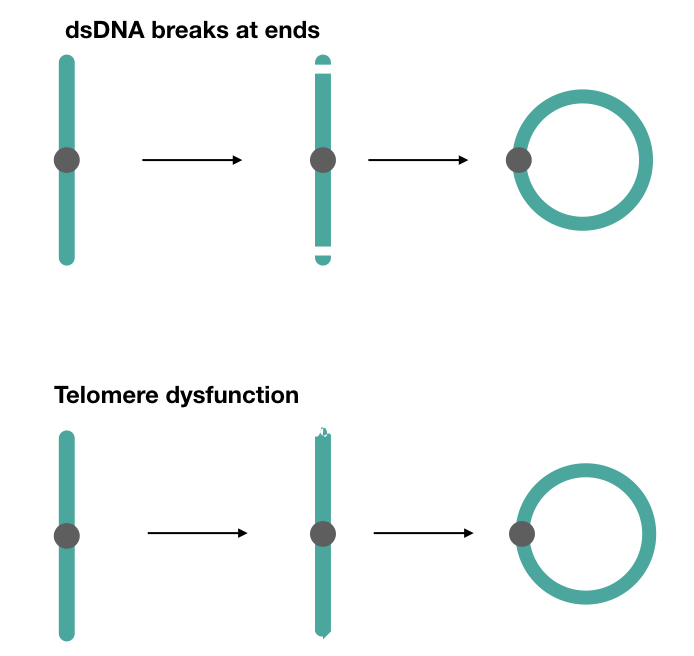The 3q29 deletion syndrome occurs by deletion of some portion from the q arm of chromosome 3 results in phenotypic alterations.
Chromosome 3 is the largest metacentric chromosome, comprises 200 million base pairs which represent 6.5% of total genomic content. Deletions are chromosome defects that occur when a part of a chromosome from either of the ends gets missing.
This including a few to too many different genes separating from the chromosome and causes serious health issues. 3q microdeletion is also a type of missing chromosome part defect which causes mild to serious problems for a person.
3q microdeletion- Genetics:
The present genetic condition occurs randomly, meaning, it occurs during the meiosis cell division of germ cells. Microdeletion mutations occur de novo– (sporadic) during cell division.
The condition is non-inherited which means that it can’t pass from parents to their offspring or don’t running in the family history too. In addition, the 3q microdeletion is the rarest genetic condition reported 1 in 30,000 to 40,000 people worldwide.
To date, around 70 to 77 causes of pure 3q microdeletion are reported. Note that the chances that the affected person can transmit this present mutation are too less. However, in some mild conditions, it may pass down to offsprings.
Molecular cytogenetic studies reveal that more than or around 20 different genes of varied sizes are deleted during the process. Although the size of deleted fragment varies from person to person henceforth number of genes deleted also varies.
The signs and symptoms of the deletion syndrome depend on which portion and in how much amount is missing.
A missing portion of ~1.6Mb region comprised of PAK2 and DLG1 genes is deleted during recurrent 3q microdeletion.

Symptoms of 3q microdeletion:
- Delayed development
- Speech delay
- Feeding difficulties
- Weight loss
- Mild to moderate intellectual disability
- Bipolar disorders
- Autism spectrum disorders
- Anxiety
- Schizophrenia
- Psychiatric disorders
- Microcephaly- small head
- Recurrent ear infection
- Frequent respiratory infection
- Problems in talking, walking and sitting
- Jaundice
- Cleft lips or palates
In addition, heart defects like patent ductus arteriosus may also be reported in some cases. The part of 3q has genes mostly associated with mental development and therefore, symptoms related to mental retardation are commonly observed.
Note that not all the symptoms are present in all patients, it depends on the amount of portion deleted.
It is also noted that the region surrounding the 3q deletion is rich in repetitive DNA which sometimes causes microduplication too. So sometimes a complex spectrum of symptoms is reported in some patients involving both deletion and duplication.
Summary:
| Condition | Explanation |
| 3q microdeletion | Missing a part of chromosome 3 q arm |
| Inheriteance pattern | Non-inherited |
| Cause | Error during meiotic cell division |
| Origin of mutation | De novo- sporadic |
| Frequency | 1 in 30,000 to 40,000 worldwide |
| Other names | Monosomy 3q29Microdeletion 3q29 syndrome 3q29 recurrent mutation 3q29 microdeletion syndrome 3q29 subtelomeric deletion syndrome |
Diagnosis of 3q microdeletion:
3 common diagnosis options available for screening and identification of 3q microdeletion, which are karyotyping, FISH and array CGH. Among these, the microarray and FISH are more accurate.
Although it is hard to find variation like the microdeletion using the conventional karyotyping technique. Relying on the microscopical analysis, only larger chromosomal aberrations can be detected easily using karyotyping.
The conventional method uses a cell culture platform in which viable cells are cultured and arrested on metaphase, here once a sufficient amount of metaphases are obtained, cells are harvested.
Metaphase plates are prepared and banded using GTG banding and observed under a microscope.
46, XY/XX, del(3)(q29q29) is the cytological indication of the 3q microdeletion (as per the ISCN nomenclature) which shows that two breakpoints on the q arm between the q29 occur on chromosome 3. The piece later gets missing.
The FISH and microarray techniques rely on hybridization, in FISH, a deletion-specific probe allows to hybridize on the chromosome region. A positive fluorescence signal indicates deletion of the q arm.
In microarray, thousands of immobilized probes are trying to hybridize on chromosome 3, if the deletion is present, hybridization occurs and provides results as positive.
Microarray results are more accurate than karyotyping and it reveals that the mission fragment size is around 1.6Mb; spamming between 195.7Mb to 197.3Mb on the q arm.
Conclusion:
3q29 microdeletion is the rarest genetic abnormality but still it is definitely creates problems for a person or parents of a baby. So it is very important to go for a karyotype during pregnancy if the female is at high risk of getting genetic abnormalities.
If you want o read more articles on deletion syndromes and other chromosomal abnormalities you can search it and read it on our blog.
